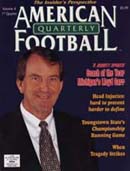Article CategoriesAFM Magazine
|
\'Hey Ref!\'Teaching Players to Deal With Officialsby: Joe Hampton Big 12 Referee © More from this issue I am convinced that during a 10 game football season, the coach and the players who understand the rules will win at least two more games than their opponents. Therefore, if 20 percent of your season is predicated on knowledge, it is imperative to learn the basic rules of the game. There is a responsibility for coaches to share their knowledge and expectations with their players in order to give them an edge in competition. My comments are not intended to take advantage of game situations or officials, but to allow coaches and their players to communicate with game officials in a fair, effective and professional manner. Some coaches have the opinion that players should never communicate with the officials during a game, regardless of the situation. Even a smaller percentage of coaches believe there is no responsibility c....The full article can only be seen by subscribers.
|
|
|||||||
| HOME |
MAGAZINE |
SUBSCRIBE | ONLINE COLUMNISTS | COACHING VIDEOS |
Copyright 2025, AmericanFootballMonthly.com
All Rights Reserved





